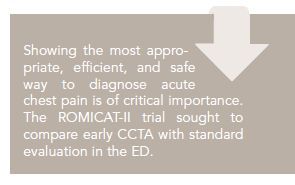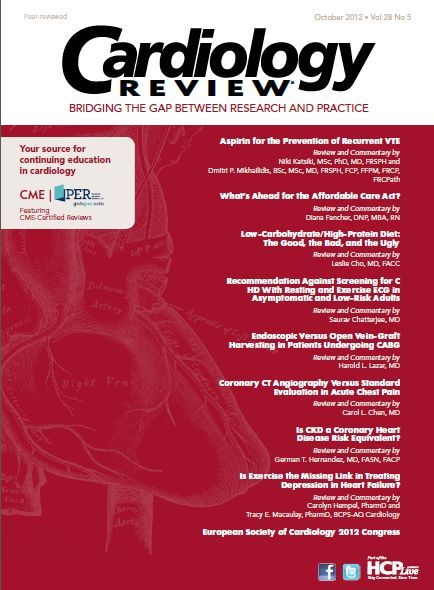Coronary CT Angiography Versus Standard Evaluation in Acute Chest Pain
Carol L. Chen, MD
Review
Hoffmann U, Truong QA, Schoenfeld DA, et al, for the ROMICAT-II Investigators. Coronary CT angiography versus standard evaluation in acute chest pain. N Engl J Med.
2012;367:299-308.

Chest pain, one of the most common complaints among patients presenting to the emergency department (ED), is estimated to cost the health care system approximately $11 billion annually. As the United States tries to contain health care costs, demonstrating the most appropriate and efficient yet safe way to diagnose acute chest pain is of critical importance. Only a small fraction of these patients are eventually diagnosed with acute coronary syndrome (ACS); the majority undergo negative workup or observation. However, a missed diagnosis of actual ACS can result in increased incidence of mortality and is of obvious concern for both patient safety and medical liability.1
Many studies have examined the use of contrast-enhanced coronary computed tomographic angiography (CCTA) in the ED. The recently published Rule Out Myocardial Infarction/ Ischemia Using Computer Assisted Tomography-II (ROMICAT-II) trial sought to compare early CCTA with standard evaluation in the ED, with a comprehensive look at safety, length of stay, cumulative cost, and radiation exposure.
Study Detalis
ROMICAT-II enrolled 1000 low- /intermediate-risk patients across 9 US medical centers, and randomized them in a 1:1 ratio to either CCTA or standard evaluation over a 2-year period. Standard evaluation predominantly involved 1 diagnostic test, such as exercise treadmill testing (ETT), stress echocardiography, or rest-stress myocardial perfusion imaging (MPI). Enrolled patients ranged in age from 40 to 74 years, presenting with at least 5 minutes of anginal symptoms within 24 hours of presentation.

Patients were excluded if they were not in sinus rhythm. Other exclusion criteria included history of coronary artery disease, new ischemic changes on initial electrocardiogram, impaired renal function, positive initial troponin, hemodynamic or clinical instability, contrast allergy, body mass index (BMI) >40, or symptomatic asthma (thus unable to receive ß-blockers for CCTA). Primary end point was length of hospital stay, and secondary end points were time to diagnosis, rate of direct discharge from the ED, resource utilization, cumulative radiation exposure, and cumulative health care costs. Before the start of this trial, the participating medical centers were not routinely performing CCTA in patients in the ED. As a safety measure, patients who were discharged within 24 hours of presentation were contacted by telephone within 72 hours to assess clinical status. Patients were followed up at 28 days to check for major adverse cardiovascular events (MACEs).
The 2 groups were similar, with no significant differences in presentation characteristics and/or discharge diagnoses. Eight percent of the study population had a final diagnosis of ACS; 6% of the CCTA group did not undergo CCTA because of patient preference, safety concerns, unavailability of CCTA, or technical difficulties.
Ninety-nine percent of the study population had a complete follow-up at 28 days.

Length of stay was significantly shorter in the CCTA arm compared with standard evaluation (mean 23.2 h vs 30.8 h; P <.001), especially in patients who did not have ACS (mean 17.2 h vs 27.2 h; P <.001). Patients who received a final diagnosis of ACS had similar lengths of stay in both arms (86.3 h vs 83.8 h; P = .87). Time to diagnosis was shorter in all CCTA patients, whether the final diagnosis was ACS or noncardiac chest pain (mean, 10.4 h vs 18.7 h; P <.001). A significantly higher proportion of patients in the CCTA arm were discharged directly from the ED (47% vs 12%, P <.001). Half of the patients in the CCTA arm were discharged within 8.6 hours of presentation as compared with only 10% in the standard evaluation arm (mean time to discharge, 8.6 h vs 26.7 h, P <.001). There were no missed ACS events in either arm, which also supports the assumption that this group is low risk. There was no difference in the rate of repeat visits to the ED or repeat hospitalizations in the 2 groups (14 vs 19, P = .38). MACE rates were not significantly different, with only 2 events in the CCTA arm versus 6 events in the standard evaluation arm at 28 days (P= .18); however, the study was likely underpowered to support a conclusion that MACE may be reduced after CCTA-based evaluations.
More diagnostic testing was performed in the CCTA group, so this group received more radiation exposure (at index plus follow-up visit 14.3 mSv/patient vs 5.3 mSv/patient, P <.001). Only 33% of the patients undergoing standard evaluation received radiation exposure from an imaging test, presumably a rest-stress MPI test or invasive coronary angiography, compared with 97% in the CCTA group. Twenty-three percent of the CCTA arm underwent an additional test beyond CCTA, 11% underwent invasive angiography, and 6% underwent revascularization. Of the standard evaluation group, 22% were discharged from index hospitalization without further testing, 68% underwent further testing, but only 11% had more than 1 test. Almost half of the patients in the standard evaluation arm underwent stress echocardiography or ETT. Cumulative mean cost of care over index visit and follow-up visits within 28 days for a subgroup of 649 patients was similar in both groups (CCTA, $4289; standard evaluation, $4060, P = .65). The authors concluded that incorporating CCTA early in ED evaluation strategy for low- and intermediate-risk patients more efficiently triaged patients compared with standard evaluation; however, this did not translate into overall cost savings.
References
1. Pope JH, Aufderheide TP, Ruthazer R, et al. Missed diagnoses of acute cardiac ischemia in the emergency department. N Engl J Med. 2000;342:1163-1170.
2. Goldstein JA, Gallagher MJ, O’Neill WW, et al. A randomized controlled trial of multi-slice coronary computed tomography for evaluation of acute chest pain. J Am Coll Cardiol. 2007;49:863-871.
3. May JM, Shuman WP, Strote JN, et al. Low-risk patients with chest pain in the emergency department: negative 64- MDCT coronary angiography may reduce length of stay and hospital charges. Am J Roentgenol. 2009;193:150-154.
4. Litt HI, Gatsonis C, Snyder B, et al. CT angiography for safe discharge of patients with possible acute coronary syndromes. N Engl J Med. 2012;366:1393-1403.
5. Goldstein JA, Chinnaiyan KM, Abidov A, et al. The CT-STAT (Coronary Computed Tomographic Angiography for Systematic Triage of Acute Chest Pain Patients
to Treatment) trial. J Am Coll Cardiol. 2011;58:1414-1422.
6. Shreibati JB, Baker LC, Hlatky MA. Association of coronary CT angiography or stress testing with subsequent utilization and spending among Medicare beneficiaries.
JAMA. 2011;306:2128-2136.
7. Hoffmann U, Bamberg F, Chae CU, et al. Coronary computed tomography angiography for early triage of patients with acute chest pain: the ROMICAT (Rule Out Myocardial Infarction using Computer Assisted Tomography) trial. J Am Coll Cardiol. 2009;53:1642-1650.
8. Amsterdam EA, Kirk JD, Diercks DB, et al. Immediate exercise testing to evaluate low-risk patients presenting to the emergency department with chest pain. J Am
Coll Cardiol. 2002;40:251-256.
9. Blankstein R, Ahmed W, Bamberg F, et al. Comparison of exercise treadmill testing with cardiac computed tomography angiography among patients presenting
to the emergency room with chest pain: the Rule Out Myocardial Infarction Using Computer-Assisted Tomography (ROMICAT) study. Circ Cardiovasc Imaging. 2012;5:233-242.
This study adds important evidence to the literature examining the role of CCTA in early diagnosis of chest pain in the ED. Earlier single-center trials suggest that decreased length of stay is linked to cost savings. 2,3 Recent large multicenter trials have consistently demonstrated a negative predictive value, greater safety,
shorter length of stay, and faster diagnosis of patients undergoing CCTA in the ED.4,5 CT-STAT, which compared early CCTA with MPI for acute chest pain, demonstrated a 38% cost savings in the CCTA arm.5 However, their study design does not reflect current clinical practice, in which many patients may be observed without an imaging study. Furthermore, some Medicare data suggest that CCTA use could increase costs.6
ROMICAT-II was designed to compare CCTA use to current clinical practice in the ED, with end points of overall costs, resource utilization, and radiation exposure. Despite a shorter length of stay, cumulative cost of care over 28 days was similar in both arms of ROMICAT- II. Reflecting real-world practice, 22% of those in the standard-evaluation arm did not require further diagnostic testing, and 49% underwent stress echocardiography or ETT, both less expensive than MPI or CCTA. Thus it is not surprising that shorter stays in the CCTA arm did not translate into cost savings.

In terms of the time involved, it is clear that a diagnostic CCTA can be completed and interpreted more quickly than MPI studies, but not necessarily more quickly than ETT or stress echocardiography. In ROMICAT, the average time to transport, to prepare the patient, and to perform CCTA was 16 minutes; expert interpretation took
9 minutes.7 In order to capitalize on the rapid diagnostic capacity of CCTA so that it might be reflected in overall lower costs, the right patient population must be chosen. In my experience, there are many clinical details that predict the utility of CCTA in a particular patient, such as likelihood of coronary calcium, obesity, inadequate heart
rate control, and the patient’s cooperation with breath holds.
ROMICAT-II did not explain why patients in the CCTA arm required more diagnostic testing. As EDs seek to increase availability of this test in local centers and in off-hours, there will likely be an increase in nondiagnostic CCTA results, thus increasing costs and redundant testing. Even in CCTA trials with well-trained staff, a small
percentage of CCTA studies were not completed. When opening a CCTA program, ED staff should be well educated regarding patient selection in order to avoid nondiagnostic test results and unnecessary radiation exposure.
This study provides comprehensive data regarding costs, radiation exposure, and resource utility, which help to define the role of CCTA as a diagnostic tool for acute chest pain. The obvious benefit of CCTA in the ED is a shorter length of stay, which is more pleasant for patients but did not translate into lower overall costs in this study. A CCTA acute chest pain pathway can potentially increase hospital costs as well as increase radiation exposure, with little benefit to the patient. Expanding its use to
community centers and aroundthe- clock availability could increase testing driven by fear of medical liability, and increase staffing costs in order to provide adequately trained interpreters on nights and weekends, and non-expert CCTA readings could hamper the accuracy of tests leading to additional downstream testing. In low-risk patients, further diagnostic testing is often not indicated in the ED, and these patients should not be inappropriately tested and exposed to radiation. In lowrisk
patients who can exercise to high workload, ETT testing has been demonstrated to be safe.8,9 However, in patients who are to undergo MPI testing, CCTA remains
an option as an initial diagnostic procedure, with a favorable cost and radiation exposure profile. By choosing the right patient and algorithm, CCTA could reduce overall
hospital costs.
About the Author
Carol L. Chen, MD, is Director of the Cardiac Intermediate Care Unit at Memorial Sloan-Kettering Cancer Center, New York, NY. She is board certified in cardiovascular medicine and echocardiography and specializes in cardiac disease in cancer patients. She received her MD from Weill Cornell Medical College. Dr Chen’s residency was at NewYork-Presbyterian Hospital Center, and she was a Fellow in Cardiology at New York University Medical Center in New York, NY.
